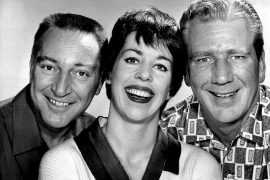
On this day in 1969, at 2:56:15 AM (GMT), Neil Armstrong became the first person to step onto the Moon. I’m up at the cottage this week, half unplugged, so here’s a giant leap into the brioux.tv archives — a replay of a salute I wrote to Armstrong, who passed away at 82 in 2012:
Have to agree with colleague David Bianculli of TV Worth Watching that the 1969 moon landing was “the best TV show I ever saw in my life.”
Neil Armstrong, who died today at 82, was the biggest star on or off the planet that summer. It was July 20, 1969 when the Apollo crew landed, and–like every July–I was up at the cottage with my parents at our own sea of tranquility, Oliphant, Ontario, somewhere on the Bruce Peninsula.
My dad helped build the wood frame cottage in 1947, and the place is still fairly On Golden Pond-ish. A septic tank was installed just two years earlier, forget a TV set, so I saw Armstrong take his odd little hop/leap off the last step of the lunar module ladder on the portable set at Oscar and Mazie’s cottage next door. The silver antenna extended all the way, the image on the 19-inch screen was black and white and fuzzy and still we all thought it was a miracle. The studio, after all, was 238,000 miles away.
I was just 12 at the time, born a few months before Sputnik–the Russian satellite that kick started the space race–was launched. Watching history unfold like this was a trip for a 12-year-old and, like everyone I knew, I ran out and bought a plastic model of the Lunar Excursion Module as soon as it arrived–in my case, at Rigbey’s hobby shop, then on Bloor Street West in Etobicoke. Some lucky kids got the whole command module to assemble. The spindly, retractable legs of the LEM drove home the whole idea of weight and gravity on the moon (before snapping off in kid’s rooms all over planet Earth).
Major Matt Mason also landed at my house soon after Armstrong’s grand adventure. The bendable spaceman was a little big for the model of the LEM, plus his arms looked like vacuum cleaner hoses.
advertisement
Crowding around that small TV set up in Oliphant, it sure sounded to me like Armstrong said, “one small step for man…,” not, “a man” as he later claimed and as was written on the plaque left on the lunar surface. It didn’t matter. The part we all got right away was the “giant leap for mankind.”
Like others, my memories of watching the event on television centre around CBS news anchor Walter Cronkite. Mopping his brow, saying “Whew!” for the rest of us, Uncle Walter brought the whole moon landing down to earth for viewers across North America. I don’t have any memory of a CBC or CTV guy calling the moon shot, or even who they might have been at the time.
What I do remember was the awe of it all, and the promise. The idea that people could do anything, that the future was going to be very cool. Everything leading up to this had been a tease–Kubrick’s 2001: A Space Odyssey, the Planetarium, Space Food Sticks. We’d all be taking commercial jets to the Sea of Tranquility by the time we were as old as Armstrong, 38 at the time.
It hasn’t quite turned out that way. Still, I’m forever thankful Oscar and Mazie brought a set up to their cottage that July and that I saw the best TV show ever in Oliphant. It is a clear, rustic place where the night sky still holds that same sense of awe. There’s never been a reason to install a proper cable or satellite reception up there — you look up over the bay at night and can see shooting stars and satellites streaking across the Milky Way; the greatest show on earth. On nights when the moon is full, the white light dances off the rippling waves of Lake Huron and washes all over Lonely Island. It is beautiful and humbling, and to this day, whenever I’m at the cottage on a clear night, I still look up at the moon and think of Neil Armstrong.







1 Comment
Armstrong did honestly believe that he had said “a man” at the time. It was only after the mission, when listening to the audio records, that he realized and admitted in several interviews that he has misspoken at the time.
As for the plaque, it contained a statement that had been agreed to at the time, which was not the same as his first words on the moon.
Apollo 11 plaque inscription: “Here men from the planet Earth first set foot upon the Moon July 1969, A.D. We came in peace for all mankind” in capital letters. The statement “We came in peace for all mankind” is derived from the 1958 National Aeronautics and Space Act’s declaration of policy and purpose:
(Signatures: Neil A. Armstrong; Michael Collins; Edwin E. Aldrin, Jr.; Richard Nixon, President, United States of America)